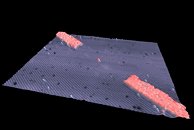Scientists Invent First Functional Single-Atom Transistor
A team of scientists at the ARC Centre for Quantum Computation and Communication, at the University of New South Wales (UNSW), unveiled a fully functional single-atom transistor, which they predict will go on to become a critical building block of tomorrow's high-performance computing devices. The new transistor design was described in a paper, published by Nature. The active component of this transistor is a single phosphorous atom patterned between atomic-scale electrodes and control gates.
Single atom transistor designs have been attempted in the past, but those designs have had an error of about 10 nanometres in positioning of the atoms, which is big enough to affect their functionality. Professor Michelle Simmons, group leader of this study, said that this is the first time "anyone has shown control of a single atom in a substrate with this level of precise accuracy," adding that "Several groups have tried this, but if you want to make a practical computer in the long-term you need to be able to put lots of individual atoms in."A video presentation by the group follows.
Single atom transistor designs have been attempted in the past, but those designs have had an error of about 10 nanometres in positioning of the atoms, which is big enough to affect their functionality. Professor Michelle Simmons, group leader of this study, said that this is the first time "anyone has shown control of a single atom in a substrate with this level of precise accuracy," adding that "Several groups have tried this, but if you want to make a practical computer in the long-term you need to be able to put lots of individual atoms in."A video presentation by the group follows.

